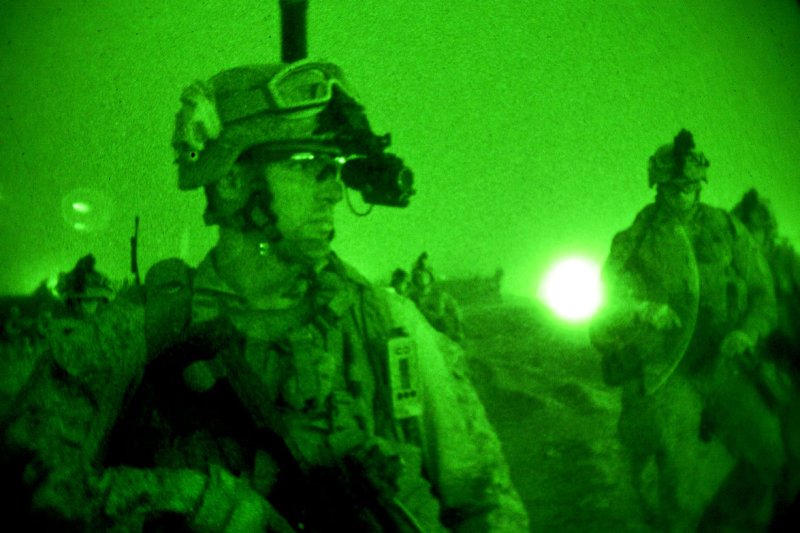As seen through a night-vision device, U.S. Marines conduct mission rehearsals on Camp Leatherneck in Afghanistan's Helmand province, July 10, 2013. The Marines, assigned to Golf Company, 2nd Battalion, 8th Marine Regiment, trained to maintain operational readiness and efficiency. .UPI/Cpl. Alejandro Pena/DoD |
License Photo
Currently, it's mostly just cats, owls, and Navy Seals that can see in the dark, but soon, night-vision technology might be available to the masses.
Researchers at the University of Michigan have developed night-vision infrared technology that could potentially be squeezed down to the size of a contact lens.
"We can make the entire design super-thin," said Zhaohui Zhong, assistant professor of electrical and computer engineering at Michigan. "It can be stacked on a contact lens or integrated with a cell phone."
Current night-vision goggles are bulky because the technology that allows users to sense the full infrared spectrum gives off heat, and requires cooling devices built in.
But this new technology operates at room temperature.
Infrared light is electromagnetic radiation featuring longer wavelengths than those of visible light. The infrared spectrum begins with wavelengths barely longer than those of visible red light and extends to wavelengths up to a millimeter.
Most know infrared light as the type that enables nighttime vision, helping nocturnal predators spying other animals in the dark. It's also helpful in spotting heat leaks in houses, can allow physicians to monitor blood flow, and can even identify chemicals in the environment and atmosphere.
Researchers developed the new technology by manipulating graphene, a single layer of carbon atoms that can sense the entire infrared spectrum, as well as visible and ultraviolet light. But but to be useful to humans, the electromagnetic radiation absorbed by the graphene needed to produce an electric signal.
On its own, graphene's signal is too weak.
"The challenge for the current generation of graphene-based detectors is that their sensitivity is typically very poor," Zhong said. "It's a hundred to a thousand times lower than what a commercial device would require."
But when scientists put a layer of insulation between two graphene sheets, they were able to create a stronger charge. The top layer absorbs the infrared light, freeing the graphene's electrons and creating positively charged holes. Using a quantum mechanical trick, those electrons slip through the insulation layer and into the bottom sliver of graphene, which has an electric charge running through it.
Ted Norris, the Gerard A. Mourou Professor of Electrical Engineering and Computer Science, worked with Zhong and a group students at Michigan to make the breakthrough.
The technology has already been scaled down to roughly the size of a small fingernail, and could be integrated into commercial products, like camera lenses and other devices, soon.
"If we integrate it with a contact lens or other wearable electronics, it expands your vision," Zhong said. "It provides you another way of interacting with your environment."
The details the research were recently published in the online journal Nature Nanotechnology.
[University of Michigan]















